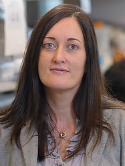Inhibition of colony stimulating factor-1 receptor abrogates microenvironment-mediated therapeutic resistance in gliomas Journal Article
| Authors: | Yan, D.; Kowal, J.; Akkari, L.; Schuhmacher, A. J.; Huse, J. T.; West, B. L.; Joyce, J. A. |
| Article Title: | Inhibition of colony stimulating factor-1 receptor abrogates microenvironment-mediated therapeutic resistance in gliomas |
| Abstract: | Glioblastomas represent the most aggressive glioma grade and are associated with a poor patient prognosis. The current standard of care, consisting of surgery, radiation and chemotherapy, only results in a median survival of 14 months, underscoring the importance of developing effective new therapeutic strategies. Among the challenges in treating glioblastomas are primary resistance and the rapid emergence of recurrent disease, which can result from tumor cell-intrinsic mechanisms in addition to tumor microenvironment (TME)-mediated extrinsic resistance. Using a PDGF-B-driven proneural glioma mouse model, we assessed a panel of tyrosine kinase inhibitors with different selectivity profiles. We found that PLX3397, an inhibitor of colony stimulating factor-1 receptor (CSF-1R), blocks glioma progression, markedly suppresses tumor cell proliferation and reduces tumor grade. By contrast, the multi-targeted tyrosine kinase inhibitors dovitinib and vatalanib, which directly target tumor cells, exert minimal anti-tumoral effects in vivo, despite killing glioma cells in vitro, suggesting a TME-mediated resistance mechanism may be involved. Interestingly, PLX3397 interferes with tumor-mediated education of macrophages and consequently restores the sensitivity of glioma cells to tyrosine kinase inhibitors in vivo in preclinical combination trials. Our findings thus demonstrate that microenvironmental alteration by CSF-1R blockade renders tumor cells more susceptible to receptor tyrosine kinase inhibition in a preclinical glioblastoma model, which may have important translational relevance. |
| Keywords: | unclassified drug; genetics; cancer combination chemotherapy; drug efficacy; nonhuman; glioma; cell proliferation; animal cell; mouse; animal; animals; mice; animal tissue; protein kinase inhibitor; animal experiment; animal model; in vivo study; antineoplastic activity; cancer cell culture; in vitro study; drug resistance; pathology; drug resistance, neoplasm; cell line, tumor; histology; cancer resistance; protein tyrosine kinase inhibitor; protein kinase inhibitors; disease model; cancer inhibition; cytokine; glioma cell; tumor cell line; tumor cell; vatalanib; single drug dose; proto-oncogene proteins c-sis; drug blood level; animal cell culture; disease models, animal; pyrroles; pyrrole derivative; tumor microenvironment; platelet derived growth factor b; becaplermin; drug effects; granulocyte macrophage colony stimulating factor receptor; receptors, granulocyte-macrophage colony-stimulating factor; colony stimulating factor 1 receptor; dovitinib; humans; human; priority journal; article; aminopyridines; bone marrow derived macrophage; aminopyridine derivative; 5-((5-chloro-1h-pyrrolo(2,3-b)pyridin-3-yl)methyl)-n-((6-(trifluoromethyl)pyridin-3-yl)methyl)pyridin-2-amine; plx 3397; csf1r protein, mouse |
| Journal Title: | Oncogene |
| Volume: | 36 |
| Issue: | 43 |
| ISSN: | 0950-9232 |
| Publisher: | Nature Publishing Group |
| Date Published: | 2017-10-26 |
| Start Page: | 6049 |
| End Page: | 6058 |
| Language: | English |
| DOI: | 10.1038/onc.2017.261 |
| PUBMED: | 28759044 |
| PROVIDER: | scopus |
| PMCID: | PMC5666319 |
| DOI/URL: | |
| Notes: | Article -- Export Date: 4 December 2017 -- Source: Scopus |
Altmetric
Citation Impact
BMJ Impact Analytics
MSK Authors
Related MSK Work







